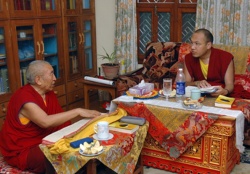Difference between revisions of "Three robes"
(Created page with "thumb|250px| <poem> '''three robes''' [三衣] (Jpn sanne ) Three kinds of garments worn by a monk according to the time or the occasion. T...") |
|||
| (4 intermediate revisions by 2 users not shown) | |||
| Line 1: | Line 1: | ||
[[File:Oral transmission.JPG|thumb|250px|]] | [[File:Oral transmission.JPG|thumb|250px|]] | ||
<poem> | <poem> | ||
| − | + | three [[robes]] | |
| − | [三衣] (Jpn sanne ) | + | [[三衣]] (Jpn [[sanne]] ) |
| − | Three kinds of garments worn by a monk according to the time or the occasion. Together with a mendicant's bowl, or begging bowl, these were the only possessions permitted a monk in India. Originally, the three robes were made only from discarded rags, symbolizing a life of humble asceticism free from secular attachments.One robe was called samghati in Sanskrit and "great robe" in China. A monk wore this robe when visiting a royal palace, going out to beg for alms, or conferring precepts. Made from nine to twenty-five pieces of cloth, it was also called the nine-patch robe. Another was called uttarasanga and "outer robe." An ordinary robe worn by monks when attending Buddhist lectures or performing rites and practices such as reciting a sutra, it was also called the seven-patch robe because it was made from seven pieces of cloth. A third robe was called antarvasa and "inner robe." It was a working garment or undergarment worn by monks while engaged in daily duties or while resting. It was also called the five-patch robe because it was made from five pieces of cloth. In India these three robes were the only garments considered proper for monks, while in China and Japan the concept and significance of the three robes gradually changed. The priests of some schools even came to wear robes of silk, brocade, or other fine fabrics, with priests of higher ranks wearing more expensive or elaborate robes. At present, Buddhist schools have their own rules concerning priestly dress. | + | Three kinds of garments worn by a [[monk]] according to the [[time]] or the [[occasion]]. Together with a mendicant's [[bowl]], or [[begging bowl]], these were the only {{Wiki|possessions}} permitted a [[monk]] in [[India]]. Originally, the three [[robes]] were made only from discarded rags, [[symbolizing]] a [[life]] of [[humble]] {{Wiki|asceticism}} free from {{Wiki|secular}} attachments.One robe was called [[samghati]] in [[Sanskrit]] and "great robe" in {{Wiki|China}}. A [[monk]] wore this robe when visiting a {{Wiki|royal}} palace, going out to beg for [[alms]], or conferring [[precepts]]. Made from nine to twenty-five pieces of cloth, it was also called the nine-patch robe. Another was called [[uttarasanga]] and "[[outer robe]]." An ordinary robe worn by [[monks]] when attending [[Buddhist]] lectures or performing [[rites]] and practices such as reciting a [[sutra]], it was also called the seven-patch robe because it was made from seven pieces of cloth. A third robe was called [[antarvasa]] and "[[inner robe]]." It was a working garment or undergarment worn by [[monks]] while engaged in daily duties or while resting. It was also called the five-patch robe because it was made from five pieces of cloth. In [[India]] these three [[robes]] were the only garments considered proper for [[monks]], while in {{Wiki|China}} and {{Wiki|Japan}} the {{Wiki|concept}} and significance of the three [[robes]] gradually changed. The {{Wiki|priests}} of some schools even came to wear [[robes]] of {{Wiki|silk}}, brocade, or other fine fabrics, with {{Wiki|priests}} of higher ranks wearing more expensive or elaborate [[robes]]. At {{Wiki|present}}, [[Buddhist]] schools have their [[own]] {{Wiki|rules}} concerning priestly dress. |
</poem> | </poem> | ||
{{R}} | {{R}} | ||
| Line 10: | Line 10: | ||
[[Category:Buddhist Terms]] | [[Category:Buddhist Terms]] | ||
[[Category:Monks]] | [[Category:Monks]] | ||
| − | [[Category:Sangha]] | + | [[Category:Sangha]]{{BuddhismbyNumber}} |
Latest revision as of 20:35, 8 March 2015
three robes
三衣 (Jpn sanne )
Three kinds of garments worn by a monk according to the time or the occasion. Together with a mendicant's bowl, or begging bowl, these were the only possessions permitted a monk in India. Originally, the three robes were made only from discarded rags, symbolizing a life of humble asceticism free from secular attachments.One robe was called samghati in Sanskrit and "great robe" in China. A monk wore this robe when visiting a royal palace, going out to beg for alms, or conferring precepts. Made from nine to twenty-five pieces of cloth, it was also called the nine-patch robe. Another was called uttarasanga and "outer robe." An ordinary robe worn by monks when attending Buddhist lectures or performing rites and practices such as reciting a sutra, it was also called the seven-patch robe because it was made from seven pieces of cloth. A third robe was called antarvasa and "inner robe." It was a working garment or undergarment worn by monks while engaged in daily duties or while resting. It was also called the five-patch robe because it was made from five pieces of cloth. In India these three robes were the only garments considered proper for monks, while in China and Japan the concept and significance of the three robes gradually changed. The priests of some schools even came to wear robes of silk, brocade, or other fine fabrics, with priests of higher ranks wearing more expensive or elaborate robes. At present, Buddhist schools have their own rules concerning priestly dress.
